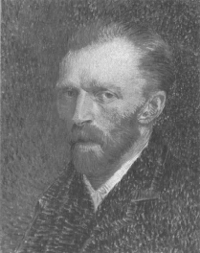Van Gogh Museum Journal 2000
(2000)– [tijdschrift] Van Gogh Museum Journal–
[pagina 90]
| |
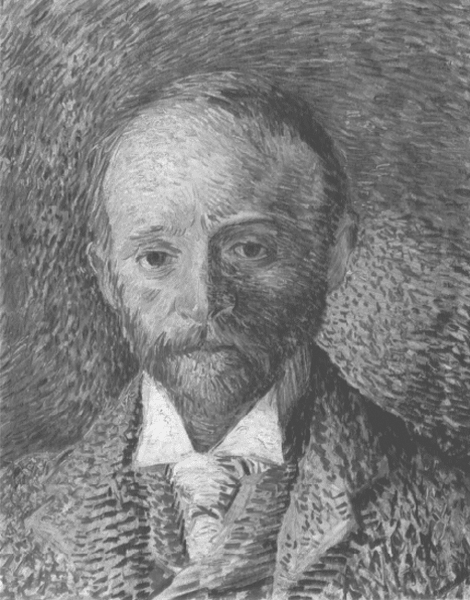 fig. 1
Vincent Van Gogh, Portrait of Alexander Reid (F 343 JH 1250), 1887, Glasgow Museums, Art Gallery and Museum, Kelvingrove | |
[pagina 91]
| |
Vincent's Scottish twin: the Glasgow art dealer Alexander Reid
| |
[pagina 92]
| |
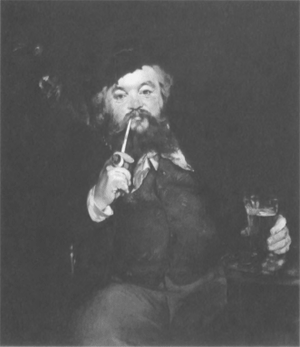 fig. 3
Edouard Manet, Le bon bock, 1873, The Philadelphia Museum of Art, Mr and Mrs Carroll S. Tyson, Jr Collection Were the Van Gogh brothers justified in their criticism of Reid, or did their opinion stem from professional rivalry rather than genuine doubts about his taste? In an attempt to answer these questions, this article will investigate Reid's and Theo's activities as art dealers and identify their areas of mutual interest, thereby ascertaining the extent to which they collaborated in promoting certain artists, and where they might be said to have been competitors. Finally, in order to assess Reid's aesthetic judgement, a brief examination will be made of the works he brought back to Scotland during the 1890s. | |
Alexander Reid in ParisAlexander Reid was born in Glasgow in 1854, when the industrial revolution in Britain was at its height. Glasgow was the second city of the Empire, enjoying huge economic expansion thanks to the growth of shipbuilding, engineering, textiles and other commercial enterprises. A new class of wealthy merchants and industrialists emerged, anxious to invest in the trappings of aristocracy and to decorate their bourgeois residences with rich furnishings and fine pictures. The second half of the 19th century in Scotland saw the rise of the art market and the ascension of the dealer, who acted as both intermediary and adviser to this new breed of collector. During the 1870s and 80s Reid's father's firm, Kay & Reid, was one of the leading picture dealers in Glasgow, specialising in Scottish art and the Hague School, for which there was a burgeoning market. By the mid - 1880s, however, a new taste had begun to develop for artists of the Barbizon School, and from the outset the younger Reid sought to encourage Scottish interest in 19th-century French art. | |
[pagina 93]
| |
Reid was anxious to acquire French pictures at competitive prices and decided to investigate the market at first hand. In the summer of 1886 he gained a position at the Paris firm of Boussod, Valadon & Cie. He was placed under Theo Van Gogh in the modern paintings section of the gallery at 19, Boulevard Montmartre, where he remained for about 18 months, from June or July 1886 until January or February 1888. According to documents in the Reid archives, the two were allotted only minimal funds with which to stock the gallery. (The actual sum quoted is £400, but, given the market value of Barbizon and Hague School paintings at this date, £4000 seems a more probable figure.) McNeill Reid records that ‘for that sum [£400] they could have a stock of 50 paintings and that, as far as the living painters were concerned, they could get all they wanted “on sale” from the painters themselves.’Ga naar voetnoot4 Reid was introduced to avant-garde art for the first time in Paris: during 1887 alone Theo handled works by Degas, Monet, Sisley, Pissarro, Gauguin and Guillaumin.Ga naar voetnoot5 As McNeill Reid indicates, Theo often took the impressionists' work ‘on sale’ (i.e. on commission), paying the artist only after a picture had been sold, and taking a commission for himself. When Reid set up his own gallery in Glasgow in 1889 he employed precisely the same system when selling contemporary Scottish art. Like Theo, he also kept a stock of more established Barbizon and Hague School painters, from which he could expect a steady income. With the impressionists, however, dealers were reluctant to let him have more than one or two works on commission to market in Scotland and he was therefore anxious to buy their paintings at a lower price. This later became a cause of tension with Theo. Shortly after Reid joined Boussod & Valadon, Theo invited him to move into the apartment at 54, Rue Lépic. At first the arrangement suited all the parties well and Vincent later recalled that Reid ‘was [very] good company for the first few months’ [580/464]. Apart from the portrait already discussed there is at least one other painted likeness and three sketches of Reid - the latter identified by Johannes van der WolkGa naar voetnoot6 - that provide a record of this brief and happy time. A letter from Robert Macaulay Stevenson to the art critic D.S. MacColl reveals that Reid eventually moved out not because of a breakdown in the friendship, but as a result of Vincent's volatile temperament. Stevenson records that before moving to Paris, Reid had been romantically involved with an American woman called Mary Bacon Martin, and had nurtured hopes of rekindling the relationship in Paris: ‘One day when, his hopes all shattered, [Reid] confided in Vincent van Gogh his troubles, Vincent gallantly suggested suicide - together. A. Reid, like a shrewd Scot, at once replied, “Topping, but I have sisters in Scotland and don't want to put them to needless trouble and worry - so if we wait till nightfall it will be all right.” Thus taken by the sentiments Vincent “fell to it” [...] Reid went out to “make arrangements” which resulted in him spending his last francs and getting as far away as Paris permitted.’Ga naar voetnoot7 In the early spring of 1887 Reid moved to a small pension at 6, Place d'Anvers, where he set himself up as an agent en chambre. Boussod & Valadon allowed employees to buy and sell works ‘on the side,’ and during this period Reid made a number of purchases, only a few of which it has been possible to trace. One of the most outstanding pictures he acquired during this period was Manet's Le bon bock of 1873 (fig. 3), which he bought for £250 and sold towards the end of his stay to the French collector Jean-Baptiste Faure for twice the original price. We also know that he bought a number of Hokusai prints from Siegfried Bing (1838-1905), which he exhibited in Glasgow in November 1889. In 1887 he bought works by Puvis de Chavannes from Durand-Ruel and exhibited the artist's Ludus pro patria of 1883 (Baltimore, Walters Art Gallery) at the Glasgow International Exhibition in 1888. He also presented his father with two works by Van Gogh: Basket of apples of 1887 (F 379 JH 1341) and a third portrait of Reid that | |
[pagina 94]
| |
has never been traced.Ga naar voetnoot8 According to Hartrick, ‘Reid got into serious trouble with his father for acquiring or investing in some of Van Gogh's work, but I cannot believe he gave much money for them, or I should have heard about it from the painter! It was the contact with such atrocities, as they seemed, that roused the ire of the parent: for, in the view of the elder picture dealer, Reid was destroying his taste for what was saleable.’Ga naar voetnoot9 James Reid sold both works to an unknown dealer for £10. In his old age Reid always admitted he had failed to recognise Van Gogh's true genius. The artists that really caught his imagination in Paris were the impressionists and the Marseilles painter Adolphe Monticelli. And it was as a result of their mutual interest in these artists that Theo, Vincent and Reid began to develop a sense of rivalry. When Reid arrived in Paris, he realised that Monticelli's recent death would release a large number of pictures onto the market. A taste for Monticelli was already forming in Scotland, largely through the efforts of the dealer Daniel Cottier (1839-1891),Ga naar voetnoot10 and Reid was anxious to develop things still further. By contrast, Monticelli was still relatively unknown in Paris, although from 1883 to 1887 his work had been readily available from Joseph Delarebeyrette, who had a shop in the Rue de Provence. Theo van Gogh sold three Monticellis in 1885, but it was only after Reid's move to France that his interest in the painter really began to grow. Vincent also became fascinated with Monticelli's work, and in 1886 produced a whole series of flower paintings that reveal his growing concern with the artist.Ga naar voetnoot11 The correspondence between Delarebeyrette and his Marseille agent Pierre Piquet, a friend of Monticelli's, reveals that it was not until October 1886 that the Paris dealer was able to sell the painter's work in any quantity. This was coincidentally around the time that Reid came to stay with Vincent and Theo at the Rue Lépic. On 26 October Delarebeyrette wrote to Piquet that ‘un étranger de passage à Paris’ (perhaps Reid) had been enquiring after pictures by Monticelli.Ga naar voetnoot12 He asked Piquet to send him several, as he now had the opportunity to sell a large number, he wrote again on 3 and 18 November to say he would be able to dispose of good quality pictures well and quickly. By the end of December 1886 the market for Monticelli's work had gathered such momentum that Piquet decided to raise his prices. We know that Reid was investing heavily in Monticelli's pictures at this time, purchased mostly from Delarebeyrette, but also from Theo himself, all six were acquired in September 1887.Ga naar voetnoot13 The Van Gogh correspondence contains only two rather vague references to the works Reid owned: a ‘lovely Monticelli landscape with poplars’ [612/488] and ‘the lovers that Reid had’ [690/542]. In general it was Monticelli's figurative works and rococo-style fêtes champêtres that appealed to Scottish collectors, rather than his landscapes and still lifes. Under Reid's influence, both Theo and Vincent developed a passion for Monticelli. In 1887 they bought four works from Delarebeyrette for their own collection and were given a fifth by Reid, possibly Vase of flowers (Amsterdam, Van Gogh Museum).Ga naar voetnoot14 Theo was later presented with a sixth, The Italian girl (Amsterdam, Van Gogh Museum), by Boussod & Valadon.Ga naar voetnoot15 In January 1888 Reid contributed a variety of works to the Monticelli retrospective held at Dowdeswell & Dowdeswell in London. Seventy-five pictures were on display, and as a result Monticelli's popularity in Britain began to soar. The dealers remarked on the Scottish enthusiasm | |
[pagina 95]
| |
for Monticelli in the introduction to their catalogue,Ga naar voetnoot16 and indeed, apart from Cottier's London agent, Elbert van Wisselingh, and a few Monticelli admirers such as Oscar Wilde and Phillipe Burty, the majority of lenders were Scottish, including R.T. Hamilton Bruce, Thomas Glen Arthur and Reid himself. In February 1888, shortly after the Dowdeswell exhibition, Vincent wrote to Theo from Arles: ‘Reid has forced the price of the Monticellis up and, since we own five, it follows that these have gone up likewise’ [580/464]. To give an indication of the swift inflation of prices, in 1886 it was possible to buy Monticelli paintings from Delabeyrette for between 50 and 100 francs, but by 1888 they were being sold for nearer 500.Ga naar voetnoot17 Due to the rising prices in Paris, Reid planned to acquire new stock directly through Monticelli's cousin in Marseilles, Fernand Delas. We do not know when Reid and Delas first met, but the two were certainly well acquainted by May 1889, when they visited the American George A. Lucas in Paris,Ga naar voetnoot18 and it seems probable that it was Delas who later provided Reid with a regular store of Monticellis to market in Scotland. As Vincent himself stated [580/464], the brothers' interest in Monticelli was only ‘indirectly financial,’ but when he moved to Arles, Reid somehow became convinced it was in order to corner the market in Monticellis. In the same letter Vincent dismissed Reid's allegations as absurd, but there can be no doubt that this marks the beginning of the Scotsman's quarrel with his two Dutch friends. Certainly Theo shared Reid's enthusiasm for Monticelli, and during his tenure at Boussod & Valadon there are as many as 43 of his pictures recorded in the ledgers.Ga naar voetnoot19 Between 1887 and 1890 Theo sold 19,Ga naar voetnoot20 but six of these were bought by Reid and several others went to Van Wisselingh, who probably sent them straight up to Scotland. The real boom time for Monticelli's work in Paris, however, did not come until after the sales of the Phillipe Burty and Daniel Cottier collections in 1891 and 1892. It thus seems that although Reid may have fuelled Vincent and Theo's admiration for this artist, they were never really competitors in the Monticelli market. As for Reid's aesthetic judgement, it seems that both Vincent and Theo appreciated rather than questioned the Scots dealer's taste. Vincent described the Monticelli Reid gave them as ‘a very fine picture,’ one which he and Theo had themselves ‘meant to get hold of’ [580/464]. He also remarked to John Russell that he found Reid ‘artistic in pleading the Monticelli cause’ [600/477a]. It is true that Reid was adept at converting his fondness for the artist into commercial gain, but at no stage did he give either brother cause to question his discernment in matters of art. We have established that despite Reid's suspicions, Theo was never truly a rival in the Monticelli market. With impressionist art, on the other hand, the Van Gogh brothers came to regard the Scottish dealer as a direct threat. Theo, Vincent and Reid often discussed the possibility of selling impressionist pictures in Britain. Initially the Dutchmen contemplated using Reid as their agent in Scotland and even planned to hold an exhibition of impressionist works that Reid would set up on their behalf. However, in the late spring or summer of 1888, an unspecified incident led Vincent to believe that Reid had severely compromised his integrity as a dealer. The correspondence gives no exact details of the matter, but it seems to have concerned a work by Guillaumin, which Reid had apparently sold at a ‘ridiculous’ price [592/472]. Theo had made his first Guillaumin sale to Dupuis in the autumn of 1887 and was | |
[pagina 96]
| |
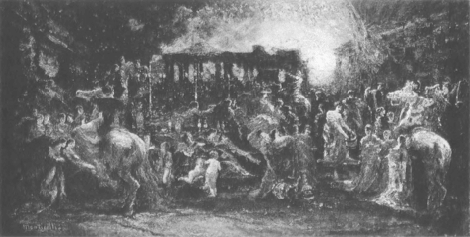 fig. 4
Adolphe Monticelli, The destruction of Pompeii, Paisley Museum and Art Gallery beginning to take a serious interest in the artist. He included Guillaumin in a mixed exhibition in December 1887 and even sent some of his work to TersteegGa naar voetnoot21 in The Hague the following spring.Ga naar voetnoot22 No doubt he also held a number of pictures on commission, but these would not have been recorded unless sold. Theo was attempting to generate a market for Guillaumin and thereby raise the price of his work. Reid appears to have been doing precisely the opposite: his aim was to reduce the value of the painter's pictures in order that he himself might acquire them at a lower price. We know that there was already a certain amount of ill feeling between Reid and the Van Gogh brothers over Monticelli, but it seems it was the Guillaumin affair that finally destroyed their friendship. Vincent's anger is clearly expressed in a letter of March 1888: ‘I think that Tersteeg and not Reid ought to start the impressionist exhibition now. I do not like Reid's behaviour toward us at all’ [592/472]. Nevertheless, there is still no evidence that Reid's aesthetic judgement was defective in any way. The few paintings we know he acquired in Paris were of high quality. The only other way of assessing his taste is by examining the works he took to Scotland. | |
Back in ScotlandReid returned to Glasgow in the spring of 1889 and set up his own gallery, which he called ‘La Société des Beaux-Arts.’ One of his first aims was to corner the market in Monticellis, and he eventually became so obsessed with this artist and so successful in promoting his work that he was widely known as ‘Monticelli Reid.’Ga naar voetnoot23 As noted above, Reid did not introduce Monticelli to Scotland, but instead sought to capitalise on an already-established taste; and although he had succeeded in raising the price of Monticelli's pictures, he was now forced to compete with a number of other Glasgow dealers in the market. His main rival was Craibe Angus (1830-1899), Daniel Cottier's agent in Glasgow, but dealers such as Thomas Lawrie (d. 1904) and W.B Paterson (1859-1952) were also beginning to stock his work. Since a large number of Monticelli's paintings have deteriorated over time, it is now difficult to judge the quality of many of the works Reid handled. However, given that | |
[pagina 97]
| |
there was so much competition, one can only conclude that aesthetic quality was one of the most important factors in attracting new clients. One of the most enthusiastic collectors of Monticelli's work during the 1890s was the textile manufacturer W.A. Coats (1853-1926). Coats loaned more Monticellis than anyone else to the International Exhibition in Glasgow in 1901, and at his death in 1926 he owned as many as 31 paintings by this artist.Ga naar voetnoot24 We know from existing receipts that Coats bought not just from Reid, but from a number of different Glasgow dealers, including Lawrie, Angus and Paterson, and that Reid was hard pressed to attract his custom. Between 1890 and early 1899 Coats bought 15 Monticellis, but none of them came from Reid.Ga naar voetnoot25 In 1899, however, he appears to have switched his allegiance and thereafter bought all his Monticellis from Reid, including the very fine Destruction of Pompeii (fig. 4), for which he paid an impressive £1,200 in 1900. With Monticelli, Reid sought to gain control of an already existing market. With impressionism, he was attempting something far more ambitious and, in many ways, more idealistic - the creation of a new taste. One of his first aims on his return to Glasgow was to realise Theo and Vincent's dream and to hold an exhibition of impressionist art in Scotland.Ga naar voetnoot26 Although Reid had invested in Manet during his stay in Paris, it was to Degas that he now turned. English collectors such as Henry Hill and Constantine Ionides had already bought works by Degas from Durand-Ruel, and it made sense to attempt to introduce Scottish buyers to impressionism through this artist. Reid's exhibition, entitled ‘A small collection of pictures by Degas and others’ opened initially in London and moved north to Glasgow in February 1892. It included a total of 46 works: seven by Degas - mainly pastels and representing a wide range of subjects; Monet's View of Vétheuil in winter (W552, present location unknown); a Sisley snow scene; and a Pissarro fan painting, The fair at St Martin, Pontoise of 1881 (P&V 1618, present location unknown). Reid also showed a selection of works by other 19th-century French artists - Puvis de Chavannes, Courbet, Corot, Daubigny, Millet and, of course, Monticelli - as well as pieces by Whistler. Reid had acquired the Pissarro from Alphonse Portier,Ga naar voetnoot27 but the majority of works on show came from Durand-Ruel. These included Degas's Woman at the window of 1871-72 (London, Courtauld Institute), which he had bought on 20 October 1891 for 3,000 francs, along with a Degas pastel of racehorses and the Sisley snow scene, both at 1,200 francs.Ga naar voetnoot28 The remaining Degas pictures comprised a café scene, two ballerina pictures - one of which was the Dancers in the rehearsal room with a double bass (New York, The Metropolitan Museum of Art), catalogued simply as ‘Répétition’ - a nude study entitled After the bath (L787, present location unknown) and At the milliner's (fig. 5). This was the first time any serious attempt had been made to market impressionism in Scotland. Thomas Glen Arthur (1857-1907), a Glasgow haberdasher, was the only buyer, purchasing At the milliner's for £800. It is certainly no coincidence that the next collector to acquire a work by Degas was Arthur's business partner, Arthur Kay (c. 1862-1939). Kay regarded himself as a true connoisseur and it is not impossible that he hoped to upstage his colleague by acquiring one of Degas's most controversial paintings, L'absinthe of 1875-76 (Paris, Musée d'Orsay). Reid had bought the picture from the sale of Henry Hill's collection at Christie's in London in February 1892.Ga naar voetnoot29 Initially Kay had | |
[pagina 98]
| |
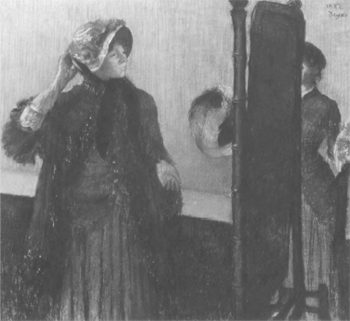 fig. 5
Edgar Degas, At the milliner's, 1882, New York, The Metropolitan Museum of Art, H.O. Havermeyer Collection, Bequest of Mrs H.O. Havermeyer, 1929 (29.100.38) great misgivings about his purchase, but his attempt to return the picture to Reid only resulted in a second acquisition, the above-mentioned Dancers in the rehearsal room. As there are no records of Reid's sales until 1899 it is difficult to form a coherent idea of the number of impressionist works bought by Scottish collectors in the 1890s. However, it seems that during this period, and indeed right up until the 1920s, only a handful of impressionist pictures were sold in Scotland, and the type of works they were reflect the conservatism of the buyers. Reid was always careful to choose neutral subjects such as still-lifes, portraits or the popular Degas ballet dancers. He also stocked a few of the more simple landscapes of Monet and Sisley, which appealed to a limited clientele. After Arthur and Kay, the next Scottish collector to buy an impressionist painting from Reid was Andrew Maxwell (1828-1909), a Glasgow iron and steel merchant, who acquired Monet's View of Vetheuil in winter by November 1892.Ga naar voetnoot30 Three years later the Glasgow ship owner George Burrell (1857-1927), a regular client of Reid's, exhibited a Degas ballet dancer at the Glasgow Institute. His brother William Burrell (1861-1958) also acquired his first works by Degas around the same time. A pastel from Burrell's collection entitled The encore (L650, present location unknown) was reproduced in The Art Jounral in 1894, and he made a second purchase, La lorgneuse (Glasgow, Burrell Collection) sometime around 1902. Another West Coast collector, Andrew Kirkpatrick (d. 1900) loaned a Monet landscape (listed under no. 231) to the Glasgow Institute in 1897 and the following year exhibited Sisley's A country village (no. 46; present location unknown). | |
[pagina 99]
| |
Despite these early purchases, Scottish collectors in general were not immediately drawn to impressionism. The majority lived in large, rather gloomy, oak-panelled houses, and the brilliant colours and sketchy handling of impressionist art sat rather uneasily among the so-called ‘glue-pot’ painters who were then in fashion. In general Reid's clients seem to have been happier with early pre-impressionist works by artists such as Manet and Degas, and Reid also kept a selection of Monet seascapes, which he knew would appeal to the West Coast collectors, many of whom were enthusiastic sailors. A typical purchase from this period was Monet's A freshening breeze of 1867 (Williamstown, MA, The Sterling and Francine Clark Institute), which was bought before 1901 by the Glasgow steel manufacturer Andrew Bain (1844-1926). Bain owned four racing yachts and was commodore of the Royal Western Yacht Club, and it seems more than likely that it was the subject matter of the painting rather than its style that appealed to him. A similar Monet picture, Seascape: night effect, dated 1864 (Edinburgh, The National Gallery of Scotland), was bought by D. McCorkindale of Carfin Hall (d. 1903) sometime before November 1903, when his collection was sold in Glasgow.Ga naar voetnoot31 Both these works could conceivably have come from the exhibition of French paintings Reid held at La Société des Beaux Arts in December 1898. The show may also have included Manet's striking Portrait of Victorine Meurent (Boston, Museum of Fine Arts) - acquired by William Burrell some time before 1901 - and another of the artist's works of the same date, Deck of a ship (Melbourne, National Gallery of Victoria), which the Edinburgh collector J.J. Cowan (1846-1933) bought from Reid in 1901 for a mere £230. Clearly, it was no easy task for Reid to persuade Scottish collectors to invest in full-blown impressionism. Apart from Sir John Richmond (1869-1963), who acquired Pissarro's Tuileries Gardens (Glasgow Museums and Art Gallery) in 1911, Scottish buyers seem to have shown little further interest in impressionism until 1917, when William Burrell began taking a serious interest in Degas. After the war Reid held regular shows of impressionist art in Glasgow, culminating in a major exhibition - Masterpieces of French art - which opened at Agnew's in London in June 1923 and moved north to the McLellan Galleries in Glasgow in August. As a result of these shows, Reid succeeded in attracting a new generation of Scottish collectors, including William McInnes (1868-1944) and D.W.T. Cargill (1872-1939), both of whom formed important collections of impressionist and post-impressionist art. Vincent Van Gogh had accused Reid of loving dead pictures and neglecting living artists, and yet even he came to realise that the only way to succeed financially was to sell. He wrote to Theo in June 1889: ‘How often I think of Reid when I am reading Shakespeare, and how often I have thought of him while I was worse than I am now. Thinking that I was far, far too hard on him and too discouraging when I claimed that it was better to care for the painters than for the pictures’ [786/597). Many of the works Reid sold were of extremely high quality, and the fact that so many of the pictures he handled are now in major international collections is surely testament to his aesthetic judgement. No other Scottish dealer came close to him in the promotion of impressionist art, and yet it was not until the 1920s that he was able to reap the benefit. If anything, then - at least as far as impressionism was concerned - it was Reid's idealism and artistic sensibility that clouded his judgement as a dealer, and not the other way round. |
|


